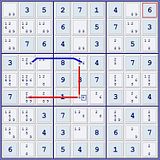aran wrote:I read Strm's move as an examination of what happens under all three possibilities for r6c8.
Thanks for that, now I get it. I’m slow but sure. Mainly sure slow.
aran wrote:The chain which you have in mind - in effect the same move seen differently-isn't "complicated" at all to write.
Well, maybe for you, you’re
aran! I’m just………..trying. Now,
ronk has already expressed this in the notation right proper for SPF (saved and duly noted.) However, considering the loop I see goes in the other direction, and you have thrown down the gauntlet, and it’s St. Paddy’s Day, I offer the following stab:
- Code: Select all
*-----------------------------------------------------------------------------*
| 89 3 5 | 2 7 1 | 4 89 6 |
| 12489 12489 1289 | 6 89 5 | 7 1289 3 |
| 1289 7 6 | 4 89 3 | 289 5 128 |
|-------------------------+-------------------------+-------------------------|
| 3 1256 12 | 8 256 4 | 25 7 9 |
| 12458 124568 128 | 9 3 7 | 258 1268 1258 |
| 7 25689 289 | 1 256 26 | 3 268 4 |
|-------------------------+-------------------------+-------------------------|
| 12589 12589 3 | 7 126 26 | 2589 4 258 |
| 1259 1259 4 | 3 12 8 | 6 29 7 |
| 6 28 7 | 5 4 9 | 1 3 28 |
*-----------------------------------------------------------------------------*
- Code: Select all
(26)r6c68=(8)r6c8-(8=9)r1c8-(9=2)r8c8-(2=1)r8c5-(1)r7c5=(26)r7c56-(2+6)r6c56=(5)r6c5 =>r6c5<>26.
Don, thanks for the info on the notation. I will study it after corned beef and cabbage at the pub (first things first.) As for this particular UR, I think of these as a pattern with an instant placement. There’s a “strong elbow” as well as a strong link on the non-“elbow” component. The non-“elbow” digit is out, don’t think twice, it’s alright.
Thumb:



